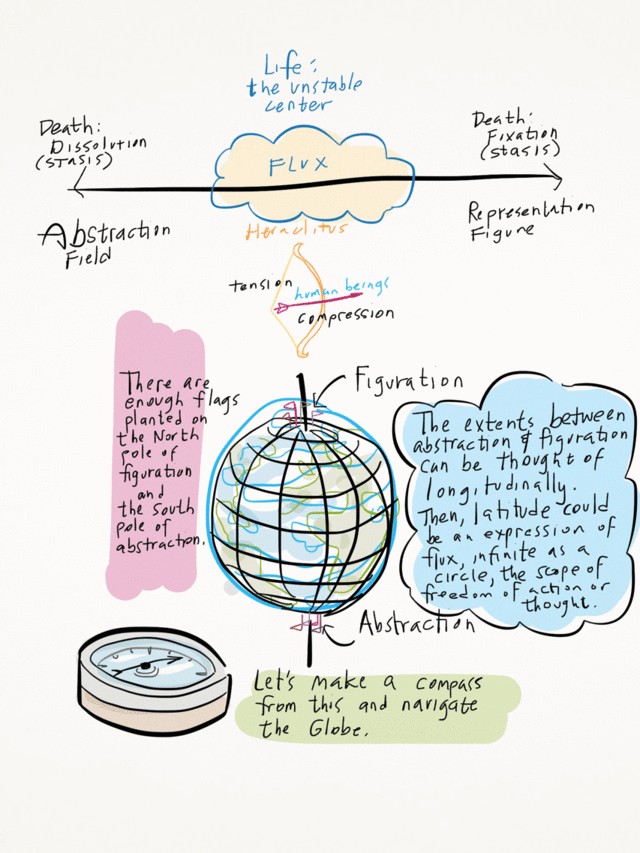August 23, 2015
Painting is a Globe
A ruler is a straight line, level like a horizon, divided into regular segments. Distinctions are drawn and sides chosen for the fight. Differences are delineated. In representation, things are figured out. Abstraction, on the other hand, tends toward the field, the all-over, the monochrome, the elimination of distinctions that characterize representation and figuration. Abstraction is erasure. Remember that Rauschenberg erased De Kooning, bringing about the postmodern eclipse of the modern and the dawn of the ultimate erasure of the conceptual.
Both poles of abstraction and representation are arrested by stasis. Each is a kind of death: the former by dissolution and the latter by fixation. The abyss and the frozen sign. Disintegration and rigor mortis. Somewhere strung between these extremes is the flux of the interpolated center, where equilibrium rapidly exchanges from one pole to the other in very, very small alternations, like the ghostly transactions of some high orbiting electron cloud.
Take this tensed line and position it into a vertical axis. Spin the line, it will arc and become longitudinal. A centrifugal force compels the stations along its length to become latitudes. We have before us, a sphere. Slewing latitudes could be an expression of flux, infinite as a circle, the scope of freedom of action or thought. Thus, a line becomes a globe and another way to see painting.
Let's call the north pole, figuration and the south pole, abstraction. Life is difficult unto impossible at the poles. Nothing grows there. One's very clothes become the last redoubt as a life support system. The closer one gets to either extent, the stranger the weather gets. What seemed simple, direct and straightforward before the journey becomes anything but straightforward at its crest. Should the flag be planted in the magnetic or geographic or political pole? There are no landmarks to establish a location. Blizzards obscure position. The goggles are iced over. Supply lines are strained and broken. The freezing temperatures have blackened fingers and toes. Life retreats to the core of the body. At the end of the day, (a fashionable phrase these days that piques my interest), does this kind of exactitude at the poles really matter? Who among us can reasonably argue that we must plant yet another flag on either pole? Like the pointless reconquest of Everest, so littered with trash, spent oxygen bottles and vainglorious corpses, hasn't the existence of the poles already been very well established by now?
The globe of painting becomes interpolated in coordinates of latitude and longitude. The painter's world becomes unfolding horizons of mountains and seas, zones of weather tropical and temperate, bays, inlets, rivers, deserts, canyons, archipelagos, ridges and peaks both abyssal and mountainous. Tropics of Capricorns and Cancer, equators and datelines mark the sphere.
Yet horizons bend and questions remain. An insertion between two known points is an interpolation. In mathematics, interpolation is a calculation, the result is fractional with a numerator and denominator, which can either be rational (finite) or irrational (infinite). What does it mean to arrive at an irrational interpolation between the poles of abstraction and representation? And finally, what does it mean that this axis between the poles of abstraction and representation require a spin and a centrifugal force to generate the planetary form of painting suggested in this essay? What causes this spin? Is the volumetric nature of paint itself, centrifugal? Does the spin rotate perfectly, or are there perturbations of significance such as precession? Would life exist on earth or in painting without such perturbations? And what exactly is the force at right angles to this axis?
Posted by Dennis at August 23, 2015 10:44 AM
Leave a comment